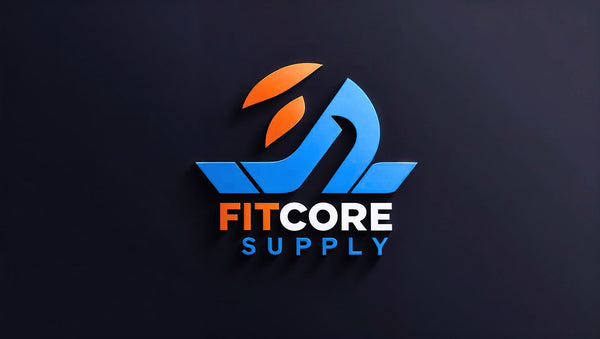






Leg Press vs Hack Squat for Ultimate Leg Growth
The leg press vs. hack squat debate really boils down to what you're trying to accomplish on leg day. If your goal is to move some serious weight and build raw strength with your back fully supported, the leg press is your powerhouse. But if you're looking to carve out detailed, well-developed quads with a movement that feels more like a natural squat, the hack squat is the clear winner.
Choosing Your Go-To Leg Day Machine
While both machines are staples for building a powerful lower body, they definitely aren't interchangeable. Getting a handle on their distinct mechanics is the key to designing an effective workout that delivers specific results, whether that’s muscle growth, pure strength, or just training safely around nagging injuries. The "best" machine is simply the one that fits your goals for that particular session.
It really just depends on what you want to achieve.
- Leg Press Key Benefits: It lets you overload your legs with maximum weight while taking almost all the stress off your spine, making it an incredible tool for building mass and strength safely. The fixed path and support reduce the need for stabilizer muscles, allowing for pure focus on the prime movers.
- Hack Squat Key Benefits: This machine encourages a deep knee bend and keeps your torso upright, which is perfect for isolating and torching your quadriceps. It helps build a strong, functional squat pattern in a controlled environment.
This infographic breaks down the choice perfectly, pointing you to the right machine based on what you want to train.
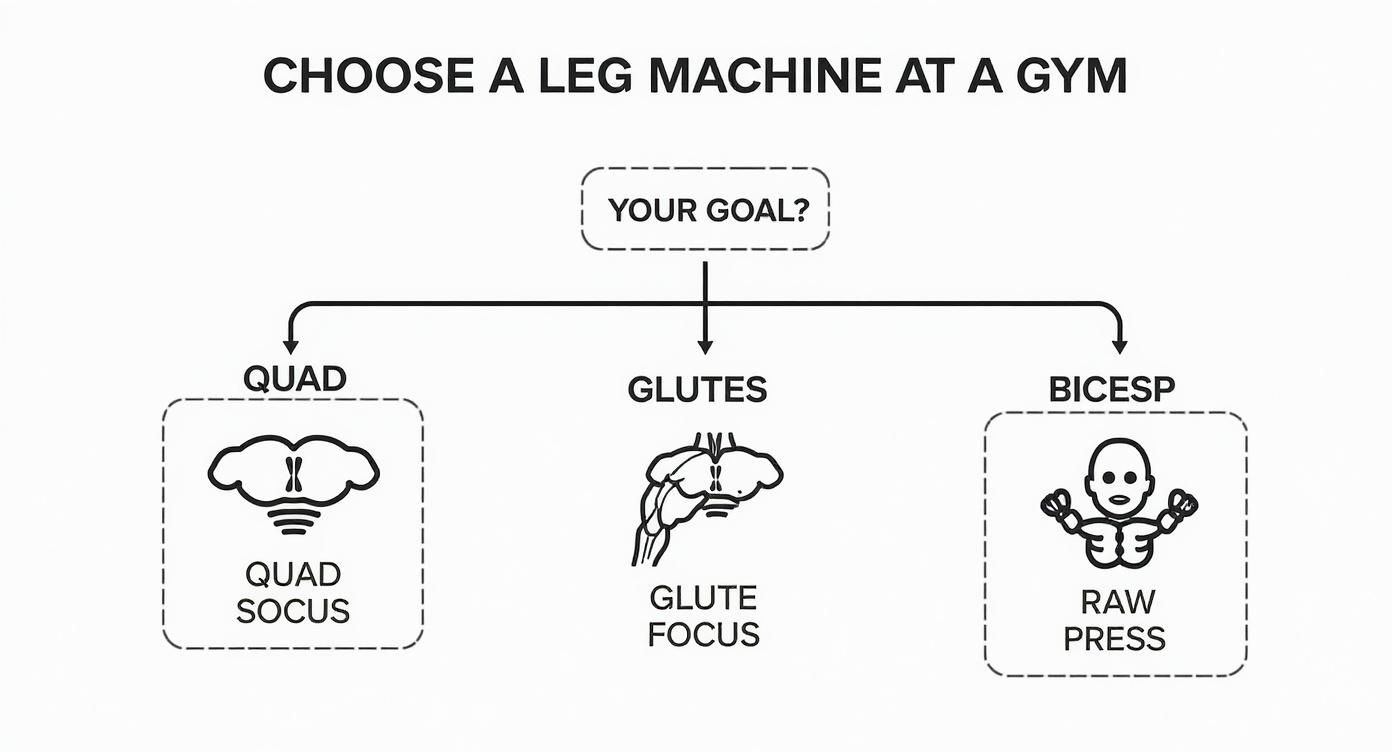
As you can see, your decision should be entirely goal-driven. For a quad-dominant day, the hack squat is your go-to. For building sheer strength or hitting your glutes hard, it's the leg press.
Key Differences At A Glance
So why pick one over the other? Lifters with lower back issues or anyone chasing a new PR often gravitate toward the leg press. On the other hand, bodybuilders frequently use the hack squat to bring out that coveted quad sweep and definition. For anyone piecing together a home gym, understanding these nuances is critical when deciding on the most essential home gym equipment.
To make it even simpler, here’s a quick side-by-side breakdown of their main features.
Quick Comparison Leg Press vs Hack Squat at a Glance
| Feature | Leg Press | Hack Squat |
|---|---|---|
| Primary Muscle Focus | Overall Leg Mass (Quads, Glutes, Hamstrings) | Quadriceps |
| Spinal Load | Minimal (Back is fully supported) | Moderate (Axial load on the spine) |
| Movement Pattern | Seated Pushing Motion | Upright Squatting Motion |
| Weight Capacity | Very High | High |
| Best For | Raw Strength, Hypertrophy, Back Safety | Quad Isolation, Squat Mechanics |
This table lays it out clearly: the leg press is about moving heavy loads and general mass-building with spinal safety, while the hack squat is a more specialized tool for zeroing in on your quads.
Breaking Down the Movement Mechanics
To really get a feel for which machine belongs in your routine, you first have to understand how they each guide your body. The differences between the leg press and the hack squat aren't just cosmetic—they completely change how your muscles fire and how your body stabilizes itself. These unique biomechanics are the reason one might feel amazing on your knees while the other lets you pile on the plates without fear.
The leg press plants you in a seated position, usually at a 45-degree angle, with your back and hips totally supported by a beefy pad. This setup locks you into a fixed path. Your only job? Drive that weighted sled away from your body. Because your spine is completely taken out of the equation, the lift becomes a pure, unadulterated expression of lower body power, isolating the quads, glutes, and hamstrings.
This is exactly why you see people loading up the leg press with staggering amounts of weight. The machine's stability removes the need for your core and smaller stabilizer muscles to work overtime, letting you channel every ounce of effort directly into your legs.
The Upright Advantage of the Hack Squat
On the flip side, the hack squat puts you in a standing position, with the weight loaded directly onto your shoulders through padded supports. Even though it also glides on a fixed track, this setup forces you to move in a way that’s much closer to a classic barbell squat. The machine still guides the motion, but the axial loading (weight pressing straight down on your spine) demands that your core switch on to keep you stable.
This upright posture also encourages a much deeper range of motion, letting most people achieve greater knee flexion than they could on a leg press. From a mechanical standpoint, the hack squat’s upright path and shoulder-loaded resistance create a more functional squat pattern, which is a major reason it’s king for building massive quads. For a deeper dive into these differences, you can explore more insights about leg machine mechanics on TuffWraps.com.
Key Takeaway: The leg press is a pure isolation exercise that protects the spine and allows for maximum weight. The hack squat is a compound movement that mimics a true squat, firing up the core and enabling a deeper range of motion to hammer the quads.
Why Movement Path Matters
So, which one should you choose? It really boils down to your goals for that specific day or training block. The leg press is an incredible tool for building sheer size (hypertrophy) and raw strength without putting any stress on your lower back. It’s the go-to for anyone working around spinal issues or for those looking to torch their legs with high-volume sets at the end of a workout.
The hack squat, however, delivers a stimulus that’s tough to replicate. Its mechanics are perfect for lifters focused on building that prominent outer quad sweep or for those trying to groove their squat form in a more controlled, stable environment. The small but critical differences in their movement paths don't just determine which muscles get hit the hardest—they also dictate how the strength you build carries over to your other lifts and daily activities.
Targeting Muscles for Maximum Hypertrophy
While both the leg press and hack squat are killer moves for building a powerful lower body, they don't go about it in quite the same way. The real difference comes down to how each machine distributes the load, which lets you zero in on specific muscles for targeted growth. Nailing this distinction is key to picking the right tool for the job.
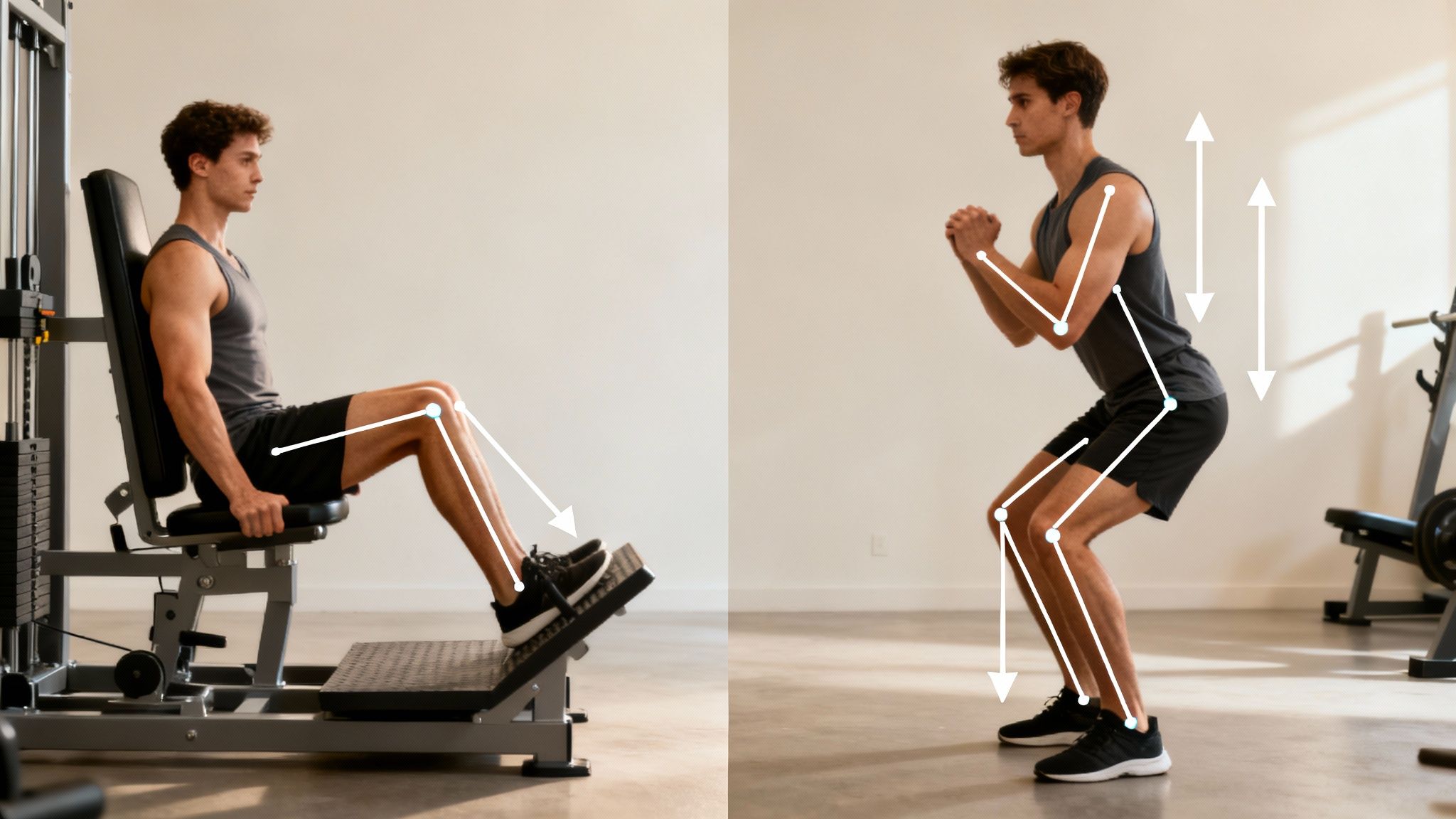
If you're looking to really isolate your quads, the hack squat is the undisputed champion. Its design locks you into an upright torso and allows for some seriously deep knee flexion. This combo forces immense tension right onto the quads—especially the vastus medialis (that teardrop muscle) and the vastus lateralis on the outer thigh. It's the perfect machine for carving out that coveted "quad sweep."
The leg press, on the other hand, is all about versatility. Sure, it can absolutely hammer your quads, but its real magic lies in its adaptability. You can completely change the focus of the exercise just by moving your feet around on the platform.
Customizing Your Leg Press Workout
Think of the leg press platform as a control panel for your lower body. A small tweak in your foot placement can lead to totally different results.
- High and Wide Stance: Placing your feet higher up and wider than your shoulders increases the bend at your hips while reducing it at your knees. This little change shifts the load away from your quads and puts it squarely on your glutes and hamstrings. It’s a fantastic way to build up your posterior chain.
- Low and Narrow Stance: Doing the opposite—placing your feet lower on the platform and closer together—maximizes knee flexion. This puts your quads under the most tension and mimics the quad-dominant focus of a hack squat.
This level of control makes the leg press an incredibly valuable piece of kit. For anyone building a home gym, a quality leg press and hack squat combo machine gives you the best of both worlds without taking up a ton of space.
Practical Scenarios: Why Choose One?
The choice between these two often comes down to your specific goals. A competitive bodybuilder getting ready for a show might live on the hack squat during the final weeks of prep. Why? Its insane quad isolation helps bring out the fine details and separation needed to pop on stage.
A powerlifter, however, might favour the leg press as an accessory lift. After their back is fried from heavy barbell squats and deadlifts, the leg press lets them keep overloading their legs with massive weight to build raw strength, all without any extra spinal compression.
Comparing Strength Potential and Load Capacity
When you're talking leg press vs. hack squat, one of the first things you’ll notice is the sheer difference in the weight you can move. Almost everyone can load up way more plates on a leg press, but let's be clear: that doesn't automatically mean you're stronger. The reason for this huge gap comes down to simple biomechanics.
The leg press gives you a massive mechanical advantage. Its seated, 45-degree angle and full-back support completely take your core and smaller stabilizer muscles out of the equation. This setup isolates your legs, letting you pour every ounce of energy into pushing the weight. That makes the leg press a monster for applying progressive overload and packing on sheer muscle mass with heavy volume.
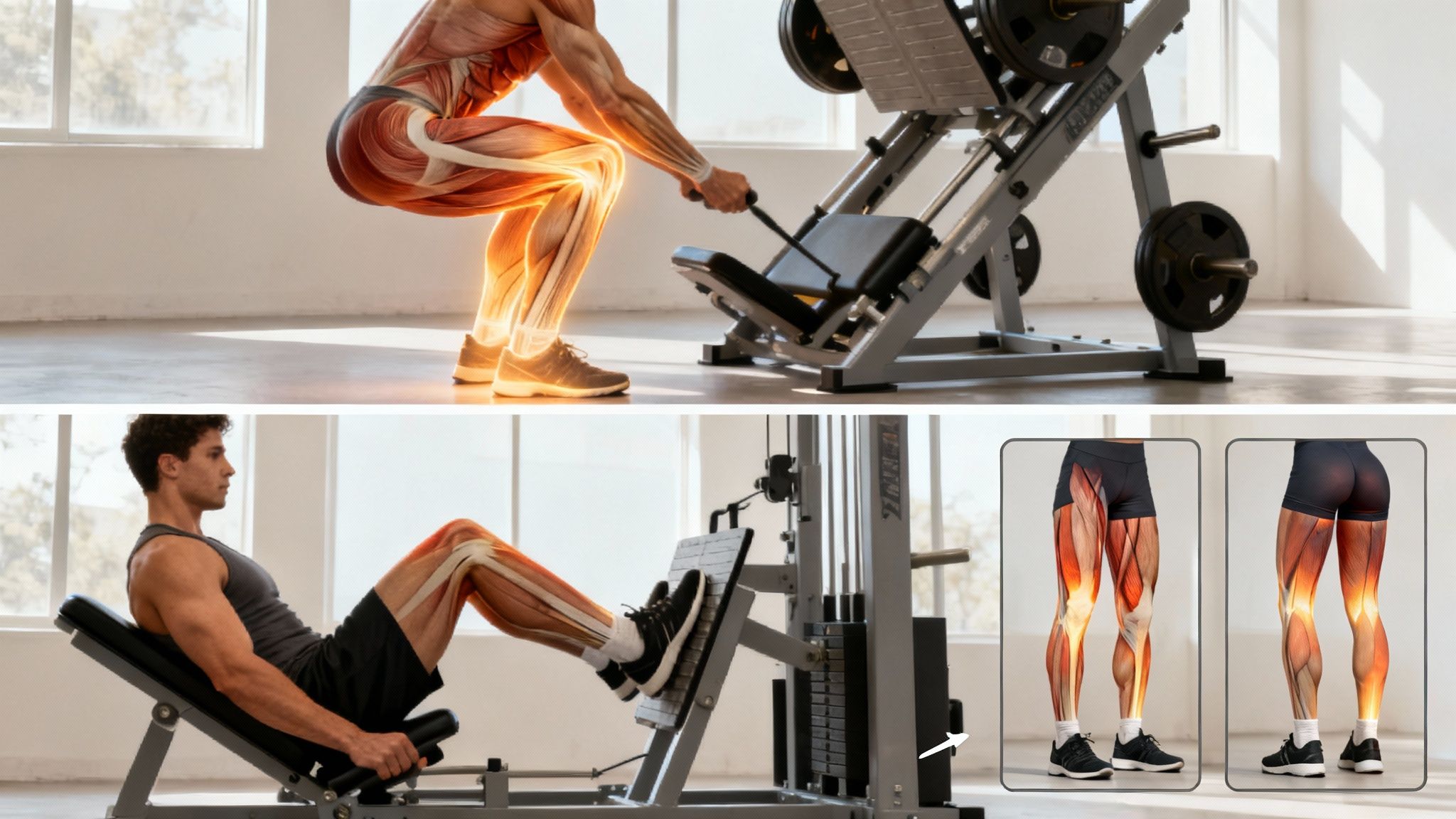
Why Hack Squat Numbers Feel Different
The hack squat, on the other hand, is a whole different beast. While the total weight on the machine is almost always lower than what you'd use on a leg press, the strength it builds is often more functional. It has a much better carry-over to athletic movements like jumping or hitting a new PR on your free-weight squats.
Because the hack squat loads the weight axially—meaning through your shoulders and spine—it forces your core and stabilizers to fire up and work hard to keep you upright. This full-body demand makes the lift feel much harder, even with less weight on the sled. Trying to compare your personal bests between these two lifts is a true apples-to-oranges situation.
Key Insight: Leg press strength is a measure of pure leg-driving power in a completely supported position. Hack squat strength is a measure of lower body power plus core stability and control, which more closely mimics real-world athletic performance.
A Look at Real-World Strength Benchmarks
Digging into logged lifts from real-world lifters gives us a clearer picture of how these machines stack up. The data actually shows that hack squats are performed far more often in training routines. The numbers also reveal some interesting trends when it comes to load capacity.
For instance, men tend to lift more on the hack squat (averaging 347 lb) compared to a single leg press (314 lb), and women show a similar trend. However, at the elite level, male lifters can push slightly higher top-end weights on the leg press, while elite female lifters achieve lifts that are a whopping 16% heavier on the hack squat. You can check out more data on strength standards for these lifts to see how you measure up.
Ultimately, both machines offer a solid path to building formidable leg strength. The leg press lets you chase maximal load to drive hypertrophy, while the hack squat develops a more integrated, functional strength that will serve you well outside the gym.
Managing Injury Risk and Training Safely
When your form is dialled in, both the leg press and hack squat are generally safe bets. But like any heavy compound lift, they each carry their own unique risks you need to be aware of. Knowing the potential pitfalls is what separates smart training from a one-way ticket to injury.
The leg press vs hack squat safety debate really boils down to your own body mechanics and any pre-existing issues you might have.
With the leg press, the single biggest danger is the infamous "butt wink." This is what happens when you go too deep, causing your hips to peel off the pad and your lower back to round. Even with the back support, that rounding action puts a ton of shearing force right on your lumbar spine. It’s the fastest way to turn a "back-friendly" exercise into a high-risk gamble.
The hack squat throws a different set of challenges at you, mainly centred on knee health and direct spinal compression. The deep knee flexion it demands can easily aggravate old knee injuries if you're not in complete control of the movement.
Protecting Your Joints on Both Machines
Your setup and execution have to be on point. Seriously, a few small tweaks can be the difference between stimulating the muscle and straining a joint.
Key Features for Leg Press Safety
- Control Your Depth: Only go as deep as you can while keeping your entire back—from shoulders to hips—glued to the pad. No exceptions.
- Own the Negative: Control the weight on the way down. Letting the sled crash puts massive stress on your joints and practically invites your hips to lift off the pad.
Key Features for Hack Squat Safety
- Nail Your Foot Placement: Set your feet so your knees track right over them for the whole rep. If your knees are caving inward, you’re asking for trouble.
- Lock in Your Upper Body: Press your shoulders and back firmly into the pads. This keeps your spine stable and properly aligned under that direct vertical load.
Why Choose One for Safety? For anyone with existing back concerns, the leg press is usually the smarter choice, as long as you eliminate butt wink. Its design offers more spinal support. On the other hand, if you have sensitive knees or spinal issues like stenosis, you’ll want to be more cautious with the hack squat due to the axial load and deep flexion it requires. Ultimately, you have to listen to your body.
Integrating Each Machine Into Your Workout
Knowing the differences between the leg press and hack squat is one thing. Actually using that knowledge to build powerful legs is another game entirely. Smart programming isn't about picking the "better" machine; it's about using the right tool for the right job at the right time.
A great way to structure your leg day is to lead with the hack squat as your primary compound lift. Hit it early in your session when you're fresh and your energy is high. This lets you lock in your form, move some serious weight, and really maximize the growth stimulus on your quads.
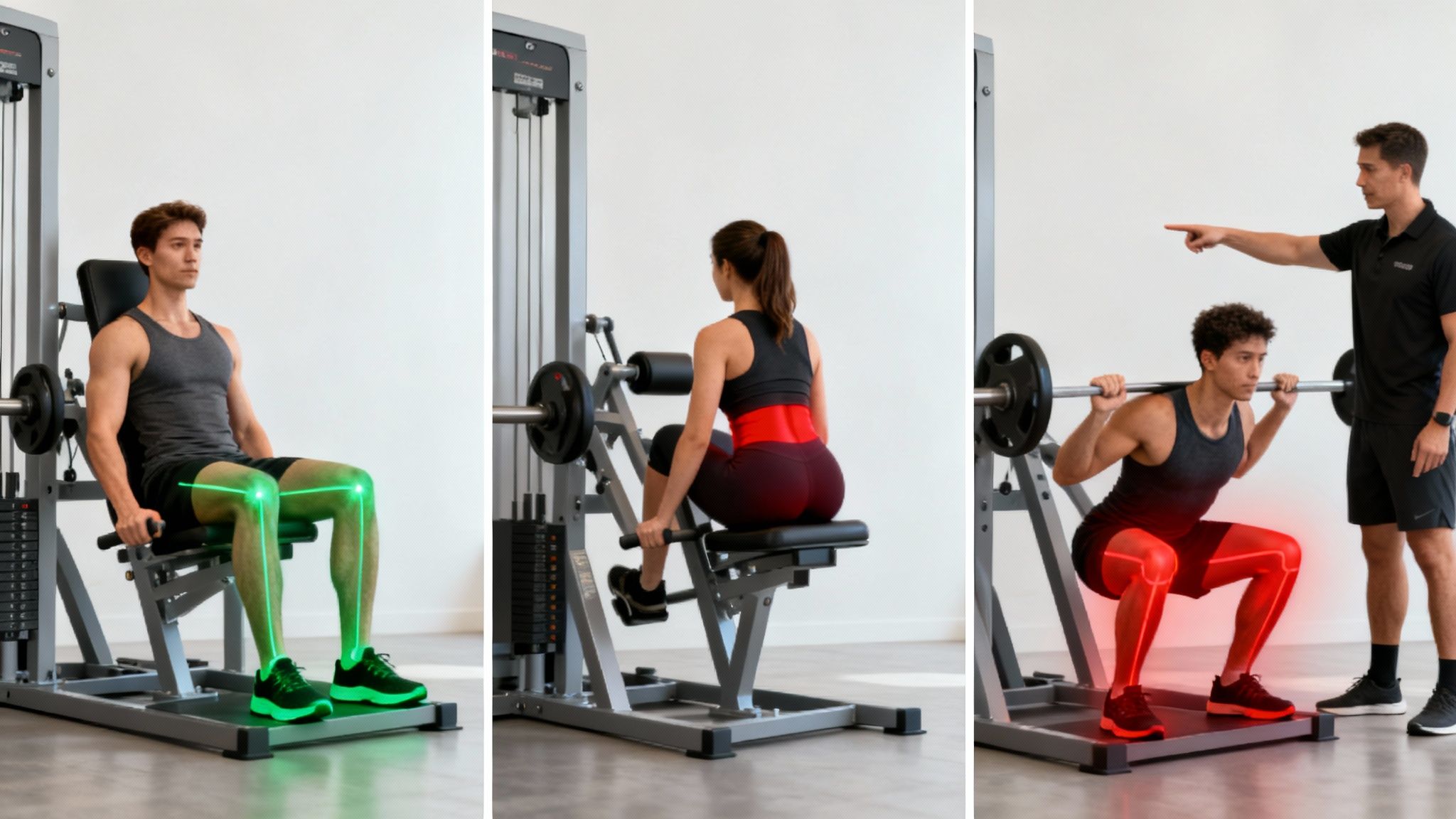
On the flip side, the leg press makes for an incredible finisher. Save it for the end of your workout to chase a massive pump and push your muscles to total failure safely. Since your back is fully supported, you can focus entirely on accumulating metabolic stress with high-volume sets without the full-body fatigue that comes from heavy, unsupported exercises.
Programming Strategies for Balanced Growth
You can weave these machines into your routine in a few effective ways, depending on your goals and training split. The key is to think about what each one brings to the table for that specific workout.
A Winning Combination:
- Hack Squat (Primary Lift): Put it first to build raw strength and size in the quads. Aim for 8-12 reps, focusing on controlled movement and getting deep into the squat.
- Leg Press (Finisher/Accessory): Use it later to rack up the volume. Push for higher reps, like 15-20, to flood the muscles with blood and trigger hypertrophy.
This approach gives you the best of both worlds—targeted quad development from the hack squat and overall leg mass from the leg press. If you're just getting started, our guide on how to start working out offers a solid foundation for structuring your sessions.
Many strength coaches I know recommend programming hack squats in the 10 to 15 rep range specifically for quad growth, while using leg presses for higher reps (15 to 20+) to maximize the pump without accumulating too much systemic fatigue. It’s a classic combo that lets you train hard while managing recovery.
Frequently Asked Questions
Let's clear up a few common questions that pop up when lifters debate the leg press vs. the hack squat. Getting straight answers will help you slot these movements into your training for safer, more effective results.
Which Machine Is Better For Building Bigger Quads?
If your goal is pure quad isolation—think building that prominent outer "sweep"—the hack squat typically gets the nod. Its upright design and deep knee flexion put a ton of direct tension right on the front of your thighs.
That said, a leg press with a low foot placement is still an absolute monster for quad growth.
Why Choose a Hack Squat? Pick the hack squat on days when maximum quad hypertrophy is the number one priority. The mechanics are practically engineered to hammer your quads through a deep, controlled range of motion that’s tough to get anywhere else.
Can I Replace Barbell Squats With These Machines?
While both machines are phenomenal for packing on leg mass, they aren't a direct swap for barbell squats. Free-weight squats demand way more from your body in terms of core stability, balance, and full-body coordination.
- Think of them as accessories: Use the leg press and hack squat as powerful tools to complement your main squat work.
- When they can be primary: If an injury stops you from squatting heavy, these machines become your best friends. They let you train your legs hard and heavy without the associated risks, making them excellent primary builders in that scenario.
Which Is Safer If I Have Lower Back Pain?
For anyone dealing with lower back issues, the leg press is usually the safer bet. It keeps your back fully supported, which takes most of the direct load off your spine. The trick is to control the weight and never let your hips curl up off the pad (often called "butt wink").
Because the hack squat is axially loaded (meaning the weight pushes down on your spine), it could potentially irritate certain back conditions. As always, talk to a professional before training through an injury.
Is One Better For Glutes?
The leg press is far more versatile for hitting your glutes. If you place your feet high and wide on the platform and focus on driving through your heels, you can shift a huge portion of the workload onto your glutes and hamstrings.
The hack squat, by its very nature, is much more quad-dominant and doesn't offer the same flexibility to emphasize your posterior chain.
Ready to add both movements to your home gym? Explore the versatile equipment at FitCore Supply and find the perfect machine to build your ultimate leg day. https://fitcoresupply.ca
